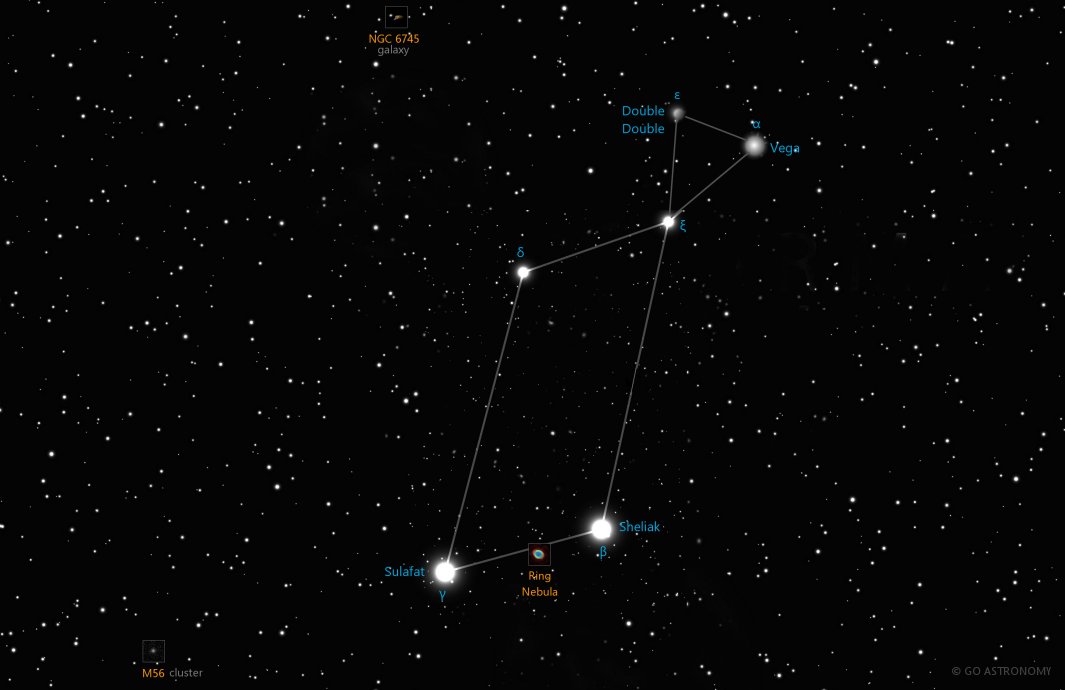Lyra, the Harp (Lyr)
(LYE-ruh)
The Northern constellation of Lyra, the Harp, is best viewed in Summer during the month of August.
Lyra is the 52nd largest constellation. It's brightest star is Vega at magnitude 0.03. The boundary of the Lyra constellation contains 58 stars that host known exoplanets.
- Pronunciation:
- LYE-ruh
- Meaning:
- Harp
- Genitive:
- Lyrae
- Abbreviation:
- Lyr
- Constellation Family:
- Hercules
- Hemisphere:
- Northern
- Quadrant:
- NQ4
- Visibility:
- 90° N - 40° S
- Best viewing month*:
- August
- Area:
- 286 sq. degrees
- Size:
- 52nd largest
- Right Ascension (avg):
- 18h 54m
- Declination (avg):
- 35°
- Meteor showers:
- Lyrids
- Brightest star:
- Vega (0.03)
- Stars with planets:
- 58
- X-ray stars:
- 2 (binary) stars
- Caldwell objects:
- |
Brightest Stars in Lyra
The 10 brightest stars in the constellation Lyra by magnitude.
- Star
- Magnitude
- Spectral class
- Alpha Lyrae (α Lyr)
- 0.03
- A0Vvar
- Gamma Lyrae (γ Lyr)
- 3.25
- B9III
- Beta Lyrae (β Lyr A)
- 3.52
- A8:V comp SB
- Lyrae
- 4.08
- M5IIIvar
- Delta Lyrae (2 Lyr)
- 4.22
- M4IIvar
- Kappa Lyrae (κ Lyr)
- 4.33
- K2IIIvar
- Zeta Lyrae (ζ1 Lyr)
- 4.34
- Am
- Theta Lyrae (θ Lyr)
- 4.35
- K0II
- Eta Lyrae (η Lyr)
- 4.43
- B2.5IV
- Epsilon Lyrae (ε2 Lyr A)
- 4.6
- A8Vn
Double Stars in Lyra
These are the brightest and easiest-to-find double, triple, and quadruple star systems in the constellation Lyra . Also see all star clusters.
- Star system
- Magnitudes
- Type
- Epsilon Lyrae
- 5.2, 6.1, 5.4, 5.4
- quadruple
- Zeta Lyrae
- 4.3, 5.6
- double
- Beta Lyrae
- 3.6, 6.7
- double
- Otto Struve 525
- 6.1, 7.6
- double
Star Clusters in Lyra
The most notable and easy-to-find star clusters in the constellation Lyra . Also see all star clusters.
Nebulae in Lyra
Notable and easy-to-find nebulae in the constellation Lyra . Also see all nebulae.
Galaxies in Lyra
The most notable galaxies in the constellation Lyra. Also see all galaxies.
The Harp in the Heavens
Lyra, Latin for "harp," is a small but significant constellation in the Northern Hemisphere. Its mythological ties, its celestial highlights, including one of the brightest stars in our night sky, and its rich field of deep-sky objects, make it a fascinating topic of study in astronomy.
Historical Overview
Known since antiquity, Lyra's depiction as a lyre?a musical instrument similar to a small U-shaped harp?is associated with Greek mythology. The instrument is said to have belonged to the musician Orpheus, whose music was so enchanting that even inanimate objects and the most ferocious of beasts were moved by it. After Orpheus's tragic death, his lyre was placed in the sky by the gods, forming what we now know as the Lyra constellation.
Location and Main Features
Lyra is nestled in the fourth quadrant of the Northern hemisphere (NQ4) and can be seen at latitudes between +90? and -40?. It is bordered by constellations Hercules, Cygnus, and Draco. Covering an area of 286 square degrees, Lyra ranks 52nd in size among the 88 constellations in the night sky.
Vega: The Jewel of Lyra
Vega (Alpha Lyrae) is the brightest star in Lyra and the fifth brightest star in the night sky, shining at a magnitude of 0.03. A mere 25 light-years away from our solar system, Vega is part of the prominent asterism known as the Summer Triangle, alongside Deneb (from the constellation Cygnus) and Altair (from Aquila). Vega is a relatively young star, about 455 million years old, and it's known for its abnormal speed of rotation, completing a spin around its axis in just over 12 hours.
Other Stars and Features
Beyond Vega, Lyra hosts a few other stars of interest. Beta Lyrae, or Sheliak, is a notable eclipsing binary star system. Gamma Lyrae, also known as Sulafat, is the second brightest star in the constellation. Epsilon Lyrae, known as the "Double Double," is a fascinating multiple star system composed of two binary pairs that can be resolved into separate stars with a small telescope.
Deep Sky Objects
The constellation Lyra is home to several deep sky objects. The Ring Nebula (M57) is one of the most famous planetary nebulas and a popular target for amateur astronomers. It is a shell of ionized gas expelled by a dying star located at its center. Another deep-sky object in Lyra is the globular cluster Messier 56. These and other deep-sky bodies in Lyra provide countless opportunities for observation and study.
Observation
Lyra is best seen in the summer months for those in the Northern Hemisphere. The constellation is relatively easy to spot due to the brightness of Vega, which serves as a perfect guide. From moderately dark sites, the Ring Nebula can be viewed using small telescopes, while the "Double Double" can be split into its components with medium-sized amateur telescopes.
* Constellation shown for northen hemisphere skies. For the southern hemisphere, constellations appear rotated 180 degrees (upside-down and left-right reversed) from what is shown. Remember that seasons are reversed too - summer in northern latitudes is winter in southern latitudes.
** Circumpolar constellations are visible year-round in the hemisphere listed (and not at all in the opposite hemisphere).





